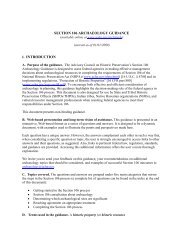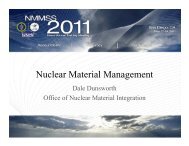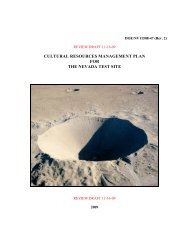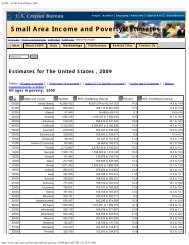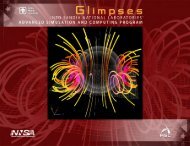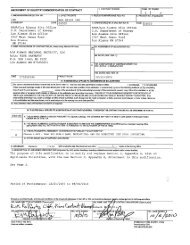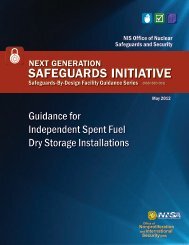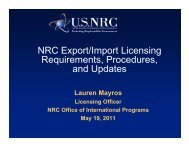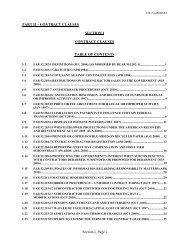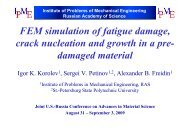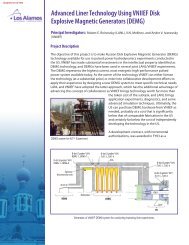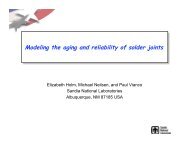- Page 1: DOE/CF-0047Volume 1Department of En
- Page 5 and 6: Office of the AdministratorWeapons
- Page 7 and 8: Volume 1Table of ContentsPageApprop
- Page 9 and 10: Department of EnergyAppropriation A
- Page 11 and 12: National Nuclear Security Administr
- Page 13 and 14: The NNSA is funded through four app
- Page 15: Although no change to the existing
- Page 19 and 20: The U.S. continues to work with the
- Page 21: Site Estimates(Dollars in Thousands
- Page 24 and 25: Outyear Direct-Funded Maintenance a
- Page 26 and 27: Office of theAdministratorPage 20
- Page 28 and 29: Page 22
- Page 30 and 31: accountable organization through th
- Page 33 and 34: Significant Program Shifts• Begin
- Page 35 and 36: Office of the AdministratorFunding
- Page 37 and 38: (dollars in thousands)FY 2009 FY 20
- Page 39 and 40: Historically Black Colleges and Uni
- Page 41 and 42: Funding Profile by Category(dollars
- Page 43 and 44: Funding Profile by Category (contin
- Page 45 and 46: Congressional Directed ProjectsFund
- Page 47 and 48: Weapons ActivitiesPage 41
- Page 49 and 50: Table of ContentsPageAppropriation
- Page 51 and 52: Weapons ActivitiesProposed Appropri
- Page 53 and 54: Weapons ActivitiesOverviewAppropria
- Page 55 and 56: In addition, select programs within
- Page 57 and 58: The NNSA will continue to meet tran
- Page 59 and 60: FY 2009ActualAppropriationFY 2010Cu
- Page 61 and 62: simulation capability, and certific
- Page 63 and 64: FY 2009ActualAppropriationFY 2010Cu
- Page 65 and 66: Directed Stockpile WorkFunding Prof
- Page 67 and 68:
DSW also interfaces with other miss
- Page 69 and 70:
Weapons Systems Cost DataA classifi
- Page 71 and 72:
FY 2009 AccomplishmentsLife Extensi
- Page 73 and 74:
defined in Section 3113 (a)(2) of t
- Page 75 and 76:
(dollars in thousands)FY 2009 FY 20
- Page 77 and 78:
(dollars in thousands)FY 2009 FY 20
- Page 79 and 80:
(dollars in thousands)FY 2009 FY 20
- Page 81 and 82:
(dollars in thousands)FY 2009 FY 20
- Page 83 and 84:
(dollars in thousands)FY 2009 FY 20
- Page 85 and 86:
FY 2011 vs.FY 2010($000)• W78 Sto
- Page 87 and 88:
FY 2011 vs.FY 2010($000)• Plutoni
- Page 89 and 90:
Major Item of EquipmentMajor Items
- Page 91 and 92:
Science CampaignFunding Profile by
- Page 93 and 94:
The Advanced Radiography subprogram
- Page 95 and 96:
Performance IndicatorsFY 2006Result
- Page 97 and 98:
Certification includes the accompli
- Page 99 and 100:
(dollars in thousands)FY 2009 FY 20
- Page 101 and 102:
Explanation of Funding ChangesAdvan
- Page 103 and 104:
Engineering CampaignFunding Profile
- Page 105 and 106:
ensure that the proper investment i
- Page 107 and 108:
Performance IndicatorsFY 2006Result
- Page 109 and 110:
FY 2009 AccomplishmentsEnhanced Sur
- Page 111 and 112:
Detailed Justification(dollars in t
- Page 113 and 114:
Explanation of Funding ChangesFY 20
- Page 115 and 116:
Inertial Confinement Fusion Ignitio
- Page 117 and 118:
schedule, and budget baseline. Repo
- Page 119 and 120:
Annual Performance Results and Targ
- Page 121 and 122:
Performance IndicatorsFY 2006Result
- Page 123 and 124:
schedule. Cryogenic layers meeting
- Page 125 and 126:
The ICF Campaign will continue to p
- Page 127 and 128:
(dollars in thousands)FY 2009 FY 20
- Page 129 and 130:
IgnitionExplanation of Funding Chan
- Page 131 and 132:
Advanced Simulation and Computing C
- Page 133 and 134:
Additionally, the ASC program and t
- Page 135 and 136:
Performance IndicatorsFY 2006Result
- Page 137 and 138:
Major Out-year Priorities and Assum
- Page 139 and 140:
(dollars in thousands)FY 2009 FY 20
- Page 141 and 142:
(dollars in thousands)FY 2009 FY 20
- Page 143 and 144:
Capital Operating Expenses and Cons
- Page 145 and 146:
Readiness CampaignFunding Profile b
- Page 147 and 148:
Annual Performance Results and Targ
- Page 149 and 150:
FY 2009 AccomplishmentsStockpile Re
- Page 151 and 152:
Detailed Justification(dollars in t
- Page 153 and 154:
(dollars in thousands)FY 2009 FY 20
- Page 155 and 156:
Advanced Design and Production Tech
- Page 157 and 158:
Major Item of EquipmentMajor Items
- Page 159 and 160:
Readiness in Technical Base and Fac
- Page 161 and 162:
Construction/Execution Readiness EI
- Page 163 and 164:
Performance IndicatorsFY 2006Result
- Page 165 and 166:
Detailed Justification(dollars in t
- Page 167 and 168:
(dollars in thousands)FY 2009 FY 20
- Page 169 and 170:
(dollars in thousands)FY 2009 FY 20
- Page 171 and 172:
(dollars in thousands)FY 2009 FY 20
- Page 173 and 174:
(dollars in thousands)FY 2009 FY 20
- Page 175 and 176:
Institutional Site SupportFY 2011 v
- Page 177 and 178:
Capital Operating Expenses and Cons
- Page 179 and 180:
TotalEstimatedCost (TEC)(dollars in
- Page 181 and 182:
11-D-801, TA-55 Reinvestment Projec
- Page 183 and 184:
TRP II Overall Scope: Consists of s
- Page 185 and 186:
(dollars in thousands)Appropriation
- Page 187 and 188:
7. Schedule of Total Project CostsF
- Page 189 and 190:
08-D-802, High Explosive Pressing F
- Page 191 and 192:
5. Financial Schedule(dollars in th
- Page 193 and 194:
(dollars in thousands)Appropriation
- Page 195 and 196:
07-D-140 Project Engineering and De
- Page 197 and 198:
07-01: Consolidate and Renovate Com
- Page 199 and 200:
(dollars in thousands)Appropriation
- Page 201 and 202:
7. Schedule of Total Project CostsF
- Page 203 and 204:
06-D-140, Project Engineering and D
- Page 205 and 206:
TA-55 Reinvestment (TRP) Phase I ha
- Page 207 and 208:
06-02: TA-55 Reinvestment Project P
- Page 209 and 210:
Fiscal Year Appropriations Obligati
- Page 211 and 212:
(dollars in thousands)PreviousTotal
- Page 213 and 214:
06-D-141, Uranium Processing Facili
- Page 215 and 216:
The UPF will reduce annual operatin
- Page 217 and 218:
(dollars in thousands)Appropriation
- Page 219 and 220:
7. Schedule of Total Project CostsF
- Page 221 and 222:
04-D-125, Chemistry and Metallurgy
- Page 223 and 224:
RLOUB Facility(dollars in thousands
- Page 225 and 226:
The project is being conducted in a
- Page 227 and 228:
(dollars in thousands)Appropriation
- Page 229 and 230:
(dollars in thousands)Appropriation
- Page 231 and 232:
(dollars in thousands)Appropriation
- Page 233 and 234:
7. Schedule of Total Project Costs(
- Page 235 and 236:
over a million and a half square fe
- Page 237 and 238:
Secure Transportation AssetOverview
- Page 239 and 240:
Annual Performance Results and Targ
- Page 241 and 242:
Secure Transportation AssetOperatio
- Page 243 and 244:
(dollars in thousands)FY 2009 FY 20
- Page 245 and 246:
Capital Operating Expenses and Cons
- Page 247 and 248:
Detailed Justification(dollars in t
- Page 249 and 250:
Nuclear Counterterrorism Incident R
- Page 251 and 252:
Annual Performance Results and Targ
- Page 253 and 254:
FY 2009 Accomplishments• Deployed
- Page 255 and 256:
Detailed Justification(dollars in t
- Page 257 and 258:
(dollars in thousands)FY 2009 FY 20
- Page 259 and 260:
(dollars in thousands)FY 2009 FY 20
- Page 261 and 262:
FY 2011 vs.FY 2010($000)Nuclear Cou
- Page 263 and 264:
Facilities and Infrastructure Recap
- Page 265 and 266:
Annual Performance Results and Targ
- Page 267 and 268:
Annual Performance Results and Targ
- Page 269 and 270:
(dollars in thousands)FY 2009 FY 20
- Page 271 and 272:
Capital Operating Expenses and Cons
- Page 273 and 274:
Site StewardshipFunding Profile by
- Page 275 and 276:
Annual Performance Results and Targ
- Page 277 and 278:
FY 2009 AccomplishmentsThe Site Ste
- Page 279 and 280:
(dollars in thousands)FY 2009 FY 20
- Page 281 and 282:
Capital Operating Expenses and Cons
- Page 283 and 284:
11-D-601, Sanitary Effluent Reclama
- Page 285 and 286:
Project JustificationThe primary ju
- Page 287 and 288:
Total Estimated Cost (TEC)6. Detail
- Page 289 and 290:
Environmental Projects and Operatio
- Page 291 and 292:
Safeguards and SecurityFunding Prof
- Page 293 and 294:
Defense Nuclear SecurityFunding Pro
- Page 295 and 296:
FY 2009 AccomplishmentsZero-Based S
- Page 297 and 298:
Detailed Justification(dollars in t
- Page 299 and 300:
(dollars in thousands)FY 2009 FY 20
- Page 301 and 302:
• Program ManagementFY 2011 vs.FY
- Page 303 and 304:
08-D-701, Nuclear Materials Safegua
- Page 305 and 306:
5. Financial Schedule(dollars in th
- Page 307 and 308:
Total Estimated Cost (TEC)6. Detail
- Page 309 and 310:
y a dedicated project team and mini
- Page 311 and 312:
Cyber SecurityFunding Profile by Su
- Page 313 and 314:
Annual Performance Results and Targ
- Page 315 and 316:
Detailed Justification(dollars in t
- Page 317 and 318:
• Cyber Security (Homeland Securi
- Page 319 and 320:
Science, Technology and Engineering
- Page 321 and 322:
Annual Performance Results and Targ
- Page 323 and 324:
Detailed Justification(dollars in t
- Page 325 and 326:
Explanation of Funding ChangesFY 20
- Page 327 and 328:
Congressionally Directed ProjectsFu
- Page 329 and 330:
Defense NuclearNonproliferationPage
- Page 331 and 332:
Table of ContentsPageAppropriation
- Page 333 and 334:
Defense Nuclear NonproliferationPro
- Page 335 and 336:
Defense Nuclear NonproliferationOve
- Page 337 and 338:
PerformanceAll of the programs with
- Page 339 and 340:
NNSA's Next Generation Safeguards I
- Page 341 and 342:
worldwide. GTRI directly supports t
- Page 343 and 344:
summary level to help senior manage
- Page 345 and 346:
Historically Black Colleges and Uni
- Page 347 and 348:
Nonproliferation and Verification R
- Page 349 and 350:
Annual Performance Results and Targ
- Page 351 and 352:
FY 2009 Accomplishments• Complete
- Page 353 and 354:
(dollars in thousands)FY 2009 FY 20
- Page 355 and 356:
Capital Operating Expenses and Cons
- Page 357 and 358:
Nonproliferation and International
- Page 359 and 360:
Annual Performance Results and Targ
- Page 361 and 362:
FY 2009 AccomplishmentsNuclear Safe
- Page 363 and 364:
The NIS funding profile also will p
- Page 365 and 366:
(dollars in thousands)FY 2009 FY 20
- Page 367 and 368:
(dollars in thousands)FY 2009 FY 20
- Page 369 and 370:
(dollars in thousands)FY 2009 FY 20
- Page 371 and 372:
(dollars in thousands)FY 2009 FY 20
- Page 373 and 374:
• Dismantlement and TransparencyE
- Page 375 and 376:
International Nuclear Materials Pro
- Page 377 and 378:
sustainability planning, nuclear se
- Page 379 and 380:
Performance Indicatorsconverted to
- Page 381 and 382:
Detailed Justification(dollars in t
- Page 383 and 384:
(dollars in thousands)FY 2009 FY 20
- Page 385 and 386:
(dollars in thousands)FY 2009 FY 20
- Page 387 and 388:
(dollars in thousands)FY 2009 FY 20
- Page 389 and 390:
• Second Line of DefenseFY 2011 v
- Page 391 and 392:
Elimination of Weapons-Grade Pluton
- Page 393 and 394:
Annual Performance Results and Targ
- Page 395 and 396:
FY 2009 Accomplishments• The Seve
- Page 397 and 398:
Explanation of Funding ChangesZhele
- Page 399 and 400:
Fissile Materials DispositionFundin
- Page 401 and 402:
Annual Performance Results and Targ
- Page 403 and 404:
Detailed Justification(dollars in t
- Page 405 and 406:
(dollars in thousands)FY 2009 FY 20
- Page 407 and 408:
(dollars in thousands)FY 2009 FY 20
- Page 409 and 410:
U.S. Surplus Fissile Materials Disp
- Page 411 and 412:
Capital Operating Expenses and Cons
- Page 413 and 414:
99-D-143, Mixed Oxide Fuel Fabricat
- Page 415 and 416:
3. Baseline and Validation Status(d
- Page 417 and 418:
(dollars in thousands)Appropriation
- Page 419 and 420:
6. Details of Project Cost Estimate
- Page 421 and 422:
10. Acquisition ApproachThe procure
- Page 423 and 424:
99-D-141-02, Waste Solidification B
- Page 425 and 426:
(dollars in thousands)TEC, TEC,OPC
- Page 427 and 428:
Other Project Cost (OPC)(dollars in
- Page 429 and 430:
FY 2008FY 2009PerformanceBaseline(d
- Page 431 and 432:
99-D-141-01, Pit Disassembly and Co
- Page 433 and 434:
CD-0 - Approve Mission NeedCD-1 - A
- Page 435 and 436:
project and design efforts will be
- Page 437 and 438:
(dollars in thousands)Appropriation
- Page 439 and 440:
7. Schedule of Total Project Costs(
- Page 441 and 442:
Global Threat Reduction Initiative
- Page 443 and 444:
applications. The Convert subprogra
- Page 445 and 446:
Performance Results and Targets(R =
- Page 447 and 448:
Detailed Justification(dollars in t
- Page 449 and 450:
(dollars in thousands)FY 2009 FY 20
- Page 451 and 452:
HEU Reactor ConvertExplanation of F
- Page 453 and 454:
Congressionally Directed ProjectsFu
- Page 455 and 456:
Naval ReactorsPage 449
- Page 457 and 458:
Naval ReactorsProposed Appropriatio
- Page 459 and 460:
Naval ReactorsOverviewAppropriation
- Page 461 and 462:
Annual Performance Results and Targ
- Page 463 and 464:
training, and logistics. Headquarte
- Page 465 and 466:
Department of Energy Working Capita
- Page 467 and 468:
Detailed Justification(dollars in t
- Page 469 and 470:
(dollars in thousands)FY 2009 FY 20
- Page 471 and 472:
(dollars in thousands)FY 2009 FY 20
- Page 473 and 474:
(dollars in thousands)FY 2009 FY 20
- Page 475 and 476:
(dollars in thousands)FY 2009 FY 20
- Page 477 and 478:
Explanation of Funding ChangesFY 20
- Page 479 and 480:
Capital Operating Expenses and Cons
- Page 481 and 482:
Outyear Major Items of Equipment(do
- Page 483 and 484:
Outyear Funding Profile by Category
- Page 485 and 486:
Explanation of Funding ChangesFY 20
- Page 487 and 488:
10-D-904, Naval Reactors Facility (
- Page 489 and 490:
(dollars in thousands)Prior Years F
- Page 491 and 492:
10-D-903, KSO Security Upgrades, Sc
- Page 493 and 494:
(dollars in thousands)Prior Years F
- Page 495 and 496:
09-D-902, Naval Reactors Facility (
- Page 497 and 498:
(dollars in thousands)Appropriation
- Page 499 and 500:
FY 2009PerformanceBaseline7. Schedu
- Page 501 and 502:
08-D-190, Expended Core Facility (E
- Page 503 and 504:
(dollars in thousands)Appropriation
- Page 505 and 506:
FY 2009PerformanceBaseline7. Schedu
- Page 507 and 508:
07-D-190, Materials Research and Te
- Page 509 and 510:
5. Financial ScheduleTotal Estimate
- Page 511 and 512:
FY 2009PerformanceBaseline(dollars
- Page 513 and 514:
Site Funding Summary(dollars in tho
- Page 515 and 516:
FUNDING BY PROGRAM:BETTIS ATOMIC PO
- Page 517 and 518:
FUNDING BY PROGRAM:KANSAS CITY PLAN
- Page 519 and 520:
ACTIVITIES:Directed Stockpile Work
- Page 521 and 522:
Cyber SecurityThe NNSA Cyber Securi
- Page 523 and 524:
ACTIVITIES:Naval ReactorsThe KAPL
- Page 525 and 526:
OUT-YEAR FUNDING:(dollars in thousa
- Page 527 and 528:
Power (HEPP) system. Also, LLNL wil
- Page 529 and 530:
Inertial Confinement Fusion Ignitio
- Page 531 and 532:
energy goals and result in cost avo
- Page 533 and 534:
FUNDING BY PROGRAM:LOS ALAMOS NATIO
- Page 535 and 536:
The site is aligned with nuclear se
- Page 537 and 538:
As part of operations at the Metrop
- Page 539 and 540:
to effectively address current and
- Page 541 and 542:
engineers in civilian activity, red
- Page 543 and 544:
OUT-YEAR FUNDING:(dollars in thousa
- Page 545 and 546:
equipment, machined hardware, and p
- Page 547 and 548:
Global Threat Reduction Initiative
- Page 549 and 550:
OUT-YEAR FUNDING:(dollars in thousa
- Page 551 and 552:
improve facility system reliability
- Page 553 and 554:
FUNDING BY PROGRAM:SANDIA NATIONAL
- Page 555 and 556:
The SNL’s Science, Technology, an
- Page 557 and 558:
Advanced Simulation and Computing (
- Page 559 and 560:
Stabilization Operations programs,
- Page 561 and 562:
FUNDING BY PROGRAM:SAVANNAH RIVER S
- Page 563 and 564:
• Provide tritium and non-tritium
- Page 565 and 566:
Facilities and Infrastructure Recap
- Page 567 and 568:
FUNDING BY PROGRAM:Y-12 NATIONAL SE
- Page 569 and 570:
• Providing safe and secure stora
- Page 571 and 572:
• Managing legacy material dispos
- Page 573 and 574:
comprehensive GTRI approach to achi
- Page 575 and 576:
ACTIVITIES:Nuclear Counterterrorism
- Page 577 and 578:
ACTIVITIES:Nuclear Counterterrorism
- Page 579 and 580:
FUNDING BY PROGRAM:IDAHO NATIONAL L
- Page 581 and 582:
an opportunity to further develop S
- Page 583 and 584:
Site DescriptionINTRODUCTION:The Oa
- Page 585 and 586:
FUNDING BY PROGRAM:PACIFIC NORTHWES
- Page 587 and 588:
assessments, policy support and non
- Page 589 and 590:
GENERAL PROVISIONS[SEC. 301. None o
- Page 591 and 592:
"(k) WAGE RATE REQUIREMENTS.—All
- Page 593 and 594:
disbursement account to be made ava
- Page 595 and 596:
(2) ADMINISTRATIVE EXPENSES DETERMI
- Page 598:
Office of the AdministratorWeapons



